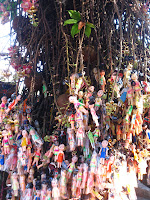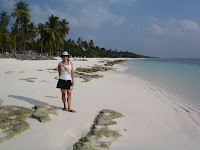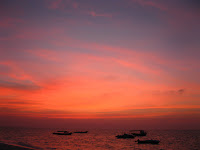

Moving southward along the western coastline, we stopped in the seaside village of Varkala, a cliff side community perched above the sparkling, blue ocean. The beach town has a well-established backpacker scene, yet seemed to cater to all age ranges. Inexpensive restaurants, plentiful accommodations, “shacky” shops galore, and several lovely, beaches are the area attractors, and we enjoyed all of the available option. Varkala seemed to be an epicenter of Kerala Ayervedic massage and spa treatments, and also a hotspot for yoga enthusiasts (mainly for Western “seekers”). Our stay was eventful in many ways, and it served as a rendezvous spot for a few of Deb’s Adobe colleagues, who live and/or work in India. Pawan and his wife Shalini and son Aadi (from Noida, near Delhi), Susan and husband Don (from Seattle/Sacramento), and Helen (from San Jose) joined us during a break from their work-related duties.
Our group lodged at a fancy, hillside hotel for a few nights of revelry and several days of fun. The Gateway Hotel (part of the high-end Indian Taj Hotel chain), featured a large swimming pool with swim-up bar and an incomparable sea view, and familiar comforts like thick, plush beds with billowy pillows, delicious dining opportunities, and nightly entertainment on the poolside lawn. We relished the luxurious surroundings, yet still ended up spending most of our days on the sand or in the sea – which was a five minute stroll down the hotel’s walkway.
One day the 8 of us ventured away from the ocean side, spending a pleasant afternoon on another of the bamboo/wood houseboats, this time exploring that regions Backwater canals, which were even more scenic (and far calmer) than the ones we’d seen previously further north near Alleppey. After a large and tasty lunch aboard the boat, it was time to return to the hotel grounds. The drive back became exciting after we realized that our driver, who’d been waiting for us, had become rather intoxicated during our little excursion. We had to yell at him to stop the car, and 5 of us got out and began to walk the 5 km back to the Gateway (Pawan and his family had a separate vehicle – fortunately with a sober driver). Eventually, an auto-rickshaw (aka – tuk-tuk) came rambling down the road, so our 5-some squeezed in to the small cart (meant to carry 3 or less adults), and ferried forth, happy to have survived the scary encounter with the drunken driver!




Our other days in Varkala were primarily beach-related, though we did explore a local and interesting Hindu temple one morning. We were blessed with many days of sunny and breezy, 90 degree weather, with perfectly warm, ocean temperatures – allowing us to make good use of seaside lounge chairs and beach umbrellas that were available to rent. The waves came with surprising abundance and were of medium-size, allowing for plenty of fine body-surfing, and we swam and played to our heart’s content. Interestingly, the locals and the travelers had separate areas for beaching/swimming, mostly to dissuade the ever-present male gawkers who walk the beach while gazing at the silky-white women in their skimpy bikinis (a persistent habit of some Indian boys and men). Our late afternoons were divided by cliff-top lunches, followed by shopping for trinkets and goods along the paved boardwalk, and sunset viewing. Evenings found us back on the cliff top for more dining and shopping in the cool of night.
We bid farewell to our companions and the two of us headed a couple hours further south, to our final stop in India, a coastal resort town called Kovalam. There we found a similar, but slightly more upscale beach scene, with a somewhat older (our age), and primarily European crowd. The main beach – Lighthouse – was extremely beautiful, framed with boulders and rocky outcroppings. At the southern end was a functioning red and white “barber-pole” colored lighthouse (hence the name), which spun it’s greenish hued light once the sun went down. The beaches in Kovalam were exceptionally clean, and we saw hardly any debris, or plastic of any kind, floating in the ocean.
Our accommodation was more modest than the swanky Gateway, but was ideally situated for enjoying the beach activities on hand. We lazed even more, read in the shade, played Frisbee by the sea, and took many dips in the Indian Ocean. Deb got her boogie board fix, and Stevo did more body surfing in the fun-sized breakers. The boardwalk ambiance was also similar to what we’d experienced in Varkala - lined with eateries, shops, and money exchangers. In the evenings, the boardwalk came alive with the glow of street lamps and many strands of colorful, “holiday-style,” twinkling lights. Again we found ourselves dining on magnificent, spicy, and unusual delicacies in the open-air cafes, followed by more late night strolling/shopping. The vendors and salespeople were a bit more aggressive than necessary, but this was a minor annoyance and actually became a source of fun-filled entertainment. Needless to say, we bought a variety of gifts and accessories for ourselves and for our family of friends back home.

The past couple of weeks along the Kerala coast were more relaxed and easy-going than were our first weeks of temple touring in Tamil Nadu. The people of India treated us well by-and-large, and nearly everyone greeting us with big smiles and hearty handshakes. Though things didn’t always proceed as planned, and we had more than a few difficulties, there were no serious setbacks or insurmountable events encountered. India is mysterious in so many ways, and some of the customs are not easily understood – nor is the way they speak English. Sometimes we were baffled by the lack of basic communication, yet with a little faith and a lot of good intention, everything worked out in a most remarkable way. No doubt, we’ll always cherish the memories of the many marvelous sights and the incredible experiences that Southern India has provided over these past 4 weeks, and someday we’ll return and explore deeper and wider in the ancient land of wonder.





























































